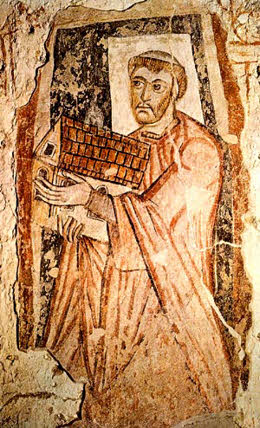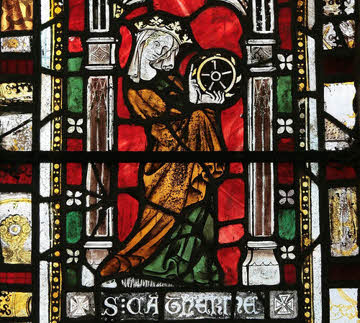|
Plinio Corręa de Oliveira
St. Benedict Biscop, a Saint Who Adorned England
Saint of the Day, Tuesday, January 11, 1966 |
|
|
St. Benedict Biscop taking St. Peter's Basilica to England Tomorrow’s Saint of the Day is as follows: Saint Benedict Biscop (pronounced “bishop”)was born in 621 to a noble Christian family in Northumberland. Educated at the Court of the King of England, he joined the army and distinguished himself particularly in the handling of weapons. King Oswi chose him as his official assistant, and Benedict took a prominent part in the military campaigns undertaken by that monarch. Although he earned prizes and proofs of esteem because of his valor in combat and fidelity to the king, Benedict took leave from military life and entered religious life. After a pilgrimage to Rome, he returned to England and dedicated himself to study and prayer for several years. He later professed in the Order of St. Benedict, founded numerous monasteries, and raised monastic fervor in those where fidelity to the rule had waned. He was a great help to Saint Theodore and Saint Adrian in their activities in England. It was St. Benedict Biscop that introduced stained glass and paintings to churches on the English island, as well as sacred music and singing. He sent for architects and artists from Italy to build and adorn the temples. He wrote a book to regularize religious feasts titled “On the Celebration of Feasts.” St. Benedict died in 690, stricken with a painful paralysis that rudely put his patience to the test.
Saint Benedict was the introducer of stained glass in the Churches of England. Saint Catherine of Alexandria, St Mary's Church - Deerhurst - England Considering the figure of St. Benedict Biscop during the period of his life as a religious, it is interesting to note his special mission. He was a religious man who belonged to the era of the saints who founded nations. Those saints who founded nations were replaced or succeeded by saints who organized nations. Evidently, he was a saint who adorned a nation. He founded artistic manifestations of religious life in England, had artists with a true Catholic inspiration come from Italy, ordered stained glass windows, sent for music, and established order in religious festivals, the only feasts known at the time. He did all that while introducing into religious life elements of beauty that would later spread from religious to civilian life. In all movements in the history of Christendom, things start in the religious life and spread to civilian life. In this way, he was England’s adorner of his time. However, this adorning bishop was not one to employ emollient, foolish, or futile adornments. His adornments had the two great elements of inspiration that every true adornment requires. First of all, meditation, reflection, and the depth of those who lead a contemplative life and design this adornment with great depth of thought, giving a beauty and a wealth of content and expression that makes it not just something that pleases the eyes and ears, but something that speaks to the mind. On the other hand, this adornment was reminiscent of old warriors, strong, enterprising men who know how to fight, who have initiative, who preside over the dawn and rise of art. Soft men, men in rags, men who have a horror of fighting are ones who live in ages when art is decadent and produce the decay of art. At the origin of every true artistic surge are saints who profoundly meditate, contemplate, and know how to be warriors. That is the lesson we can draw from the life of St. Benedict Biscop. |
|



